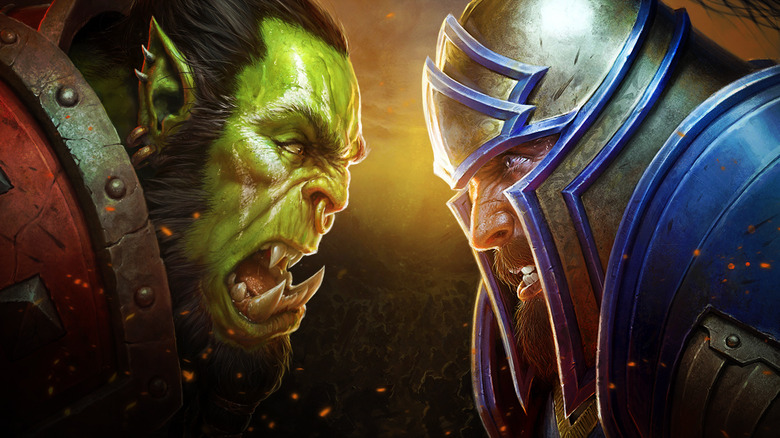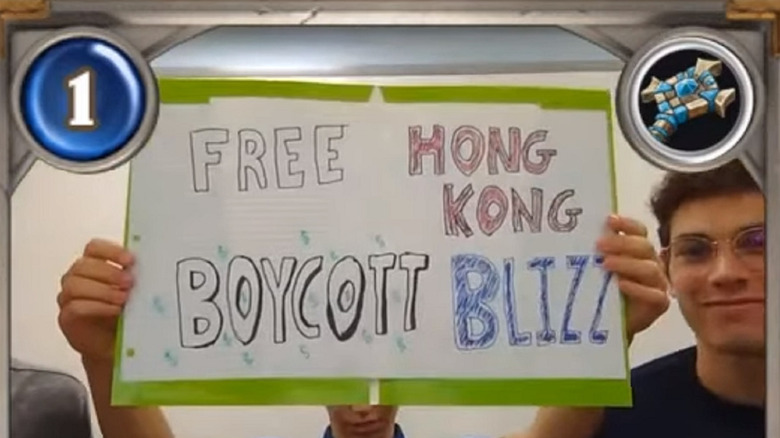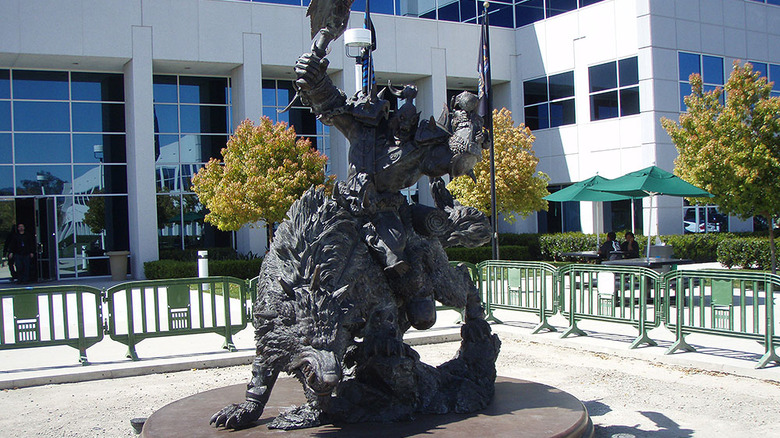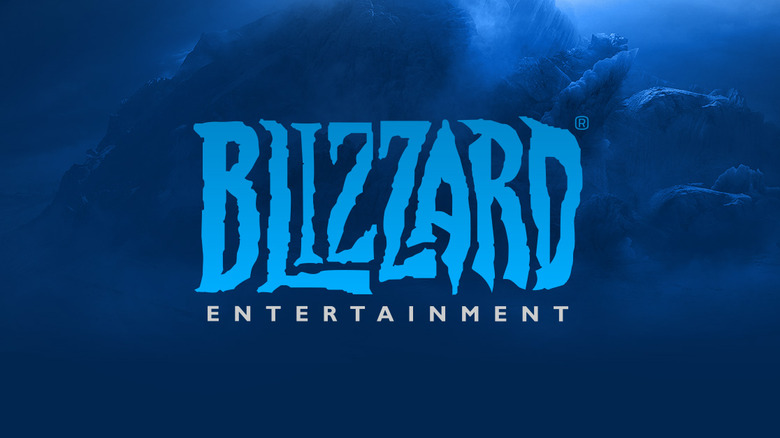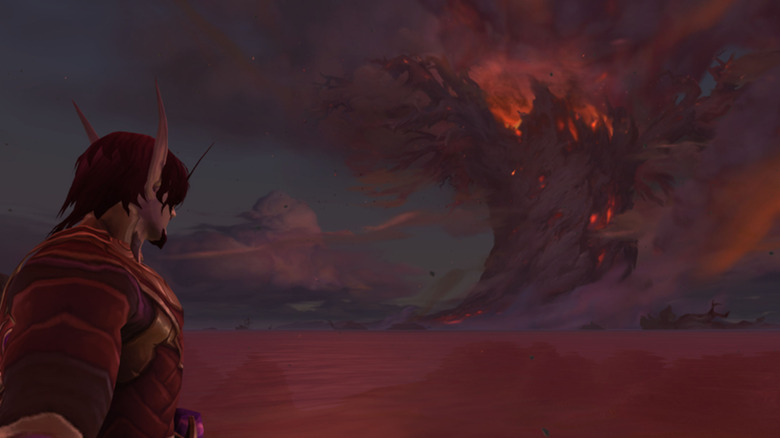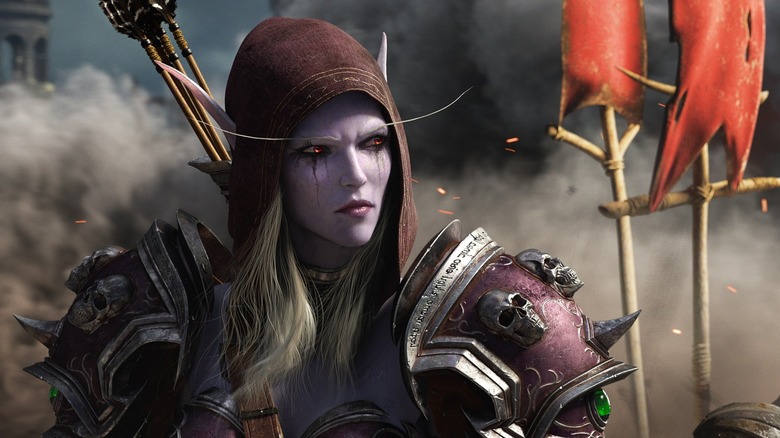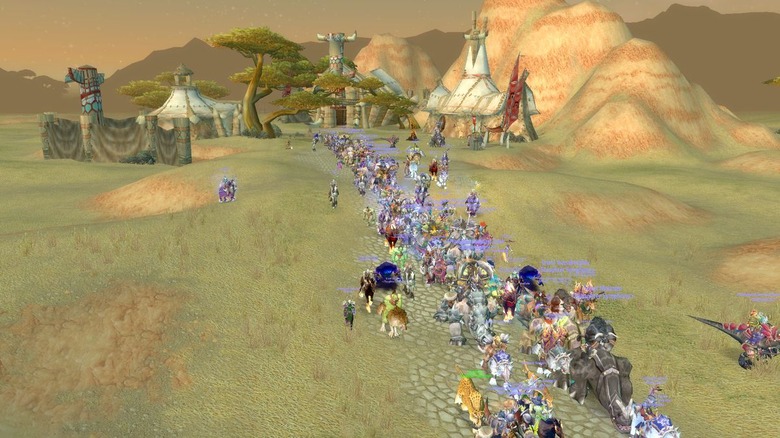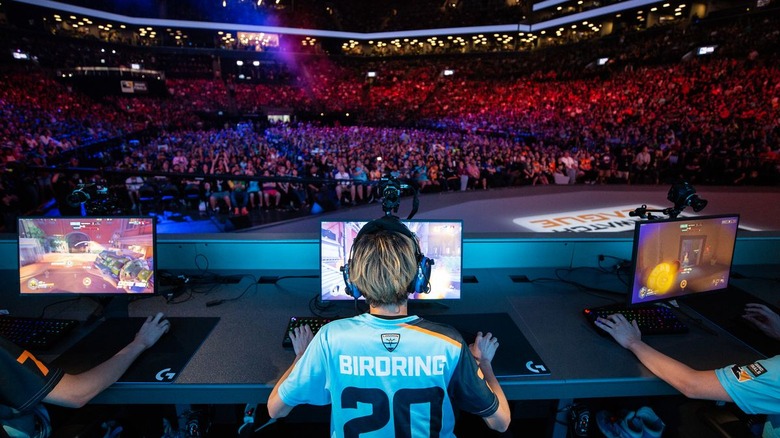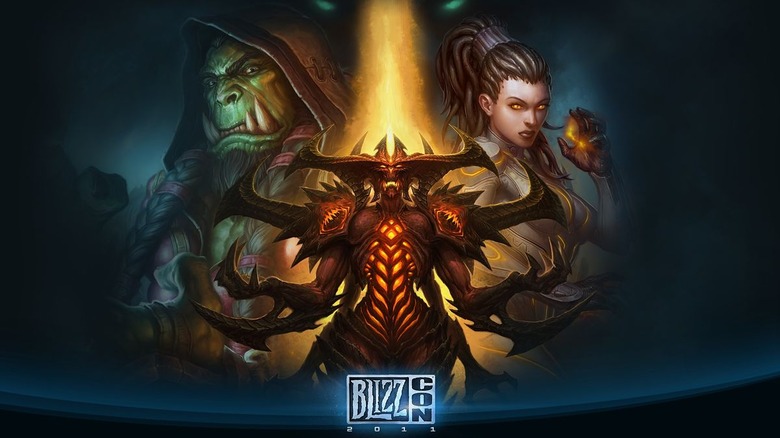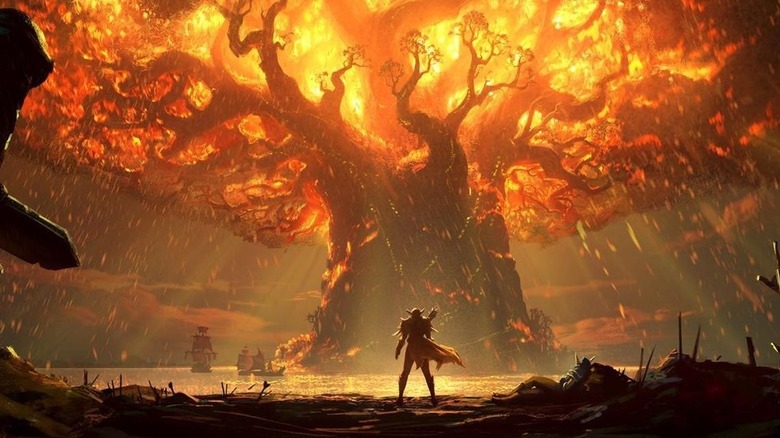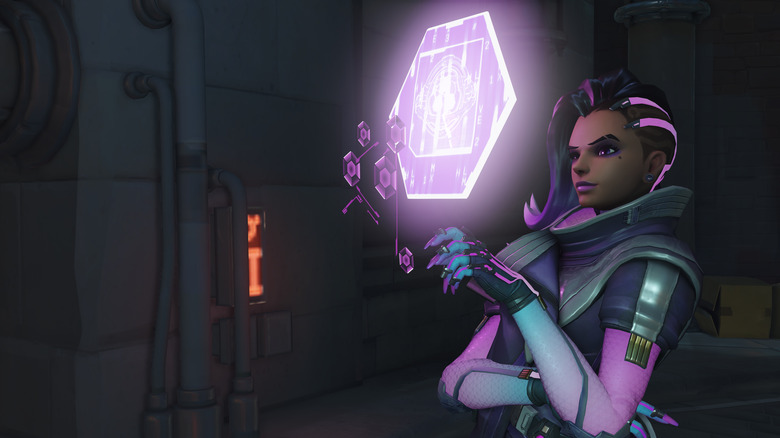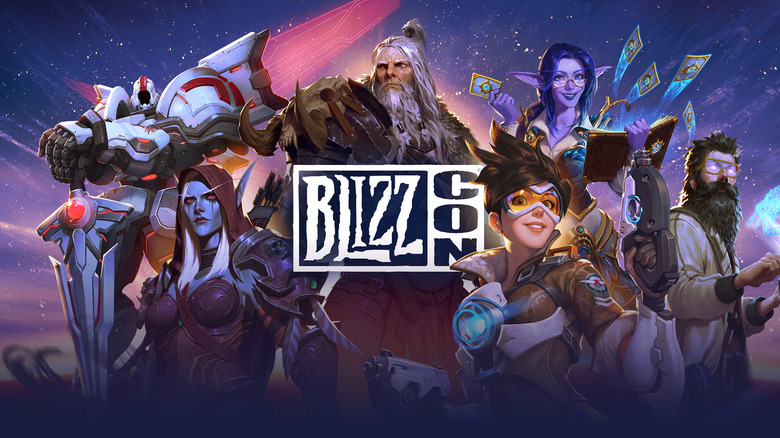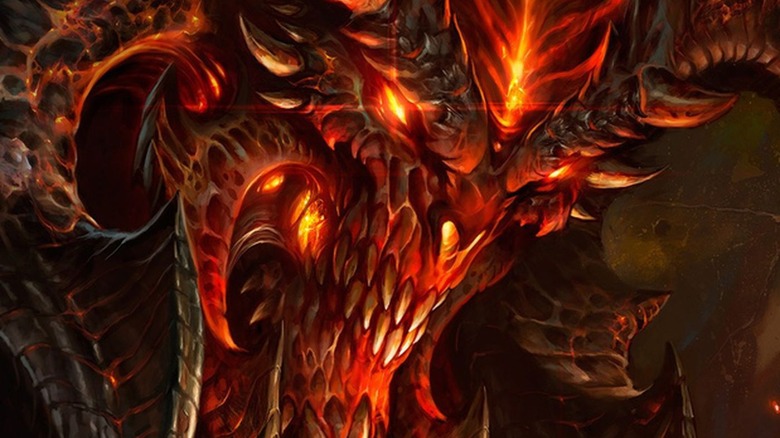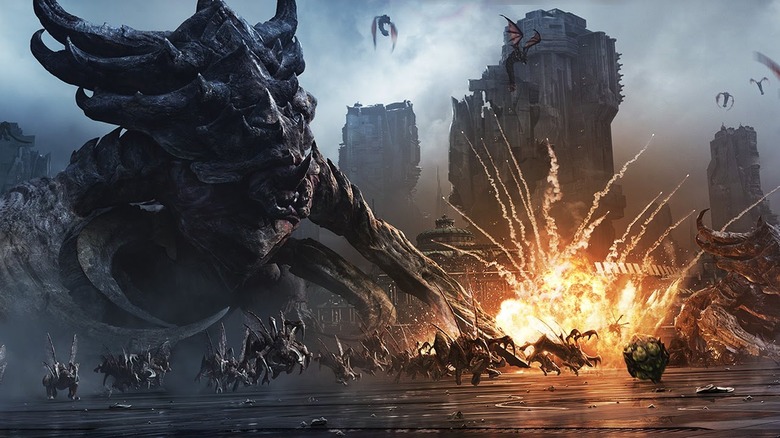The Shady Side Of Blizzard
Blizzard has proven to be a powerhouse in the gaming industry over and over again. The company has produced not one, not two, but five hugely popular franchises that command legions of players on the daily. We're talking Warcraft, Diablo, Hearthstone, StarCraft, and Overwatch, some of the most popular games in the world. Blizzard seems to have cornered the market for inventive, downright addictive experiences. But being big, having such bombastic success, and even having millions of fans has its downsides, believe it or not.
When Blizzard oversteps, overreaches, or otherwise goofs up, the whole world sees it and takes note. Despite the appeal of their games, fans haven't forgotten past — or current — controversies. These scandals mar their view of the company and have even been caused players to abandon some of their favorite games. Usually, we hear good things about Blizzard, but every multi-million dollar corporation has its dark side. Blizzard's shady side can be as cold and brutal as its namesake.
The Blitzchung ban might be Blizzard's shadiest move yet
Ng Wai "Blitzchung" Chung was one of Hearthstone's top players. Was. He had been playing the game for four years, ultimately playing at the 2019 Hearthstone Grandmasters Event, where he earned some serious winnings. During an official interview broadcast to Twitch, he took the opportunity to express his support for the Hong Kong protests raging in his home country. Because of this, Blitzchung was banned for a year, his winnings taken, and the two casters who interviewed him were fired.
Following this controversial action, #BoycottBlizzard began trending on Twitter. Many longtime players deleted their accounts en masse. Blizzard ostensibly stated that Blitzchung's ban was because players aren't supposed to make statements that bring up disputes or call out certain groups, but the internet at large — and even some US Congresspeople — called out Blizzard for allegedly taking China's side in the Hong Kong conflict.
Inside Blizzard, employees have staged walk-outs, papering over script on the Irvine office's orc statue that states, "Every voice matters." They too, believe that the company caved to China because of the money Blizzard makes there. Blizzard says their actions have nothing to do with China, but this statement hasn't convinced upset fans.
Free Hong Kong. Boycott Blizzard. Get banned.
Following the ban of pro player Blitzchung over his pro-Hong Kong statements, Blizzard tried to mop up their PR mess by reducing Blitzchung's ban and reinstating his prize money. However, the internet was again furious at Blizzard following another ban: this time three American University players felt Blizzard's cold shoulder after they held up a sign during a stream which said, "Free Hong Kong. Boycott Blizz."
Blizzard took its sweet time throwing down the banhammer. Even after their message of protest went public, they weren't banned until a week later. One of the players, Casey Chambers, told CNN about the delay, "It was hypocritical for Blizzard to punish Blitzchung's pro-human rights statement but not our clearly anti-Blizzard protest." So while their eventual ban supports Blizzard's statement that anyone caught making political statements will be punished, this really doesn't help Blizzard from a PR perspective. The fact is that Blizzard banned players for making statements that many people feel sympathetic toward; even if the company didn't discriminate when it comes to who is making that statement, it's not a good look. While other game developers like Epic Games make pledges to support free speech, Blizzard hands out bans.
Blizzard's record year, and record layoffs
As one might imagine, Blizzard makes a lot of money. Like, a whole lot. In fact, parent company Activision Blizzard enjoyed a "record year" in 2018, earning $7.5 billion in revenue, which was more than the folks in finance had expected. Despite making cash hand over fist, following the fanfare of the legendary record year, Activision Blizzard announced that they would be laying off 8% of their staff. Approximately 800 people would lose their jobs after the record year.
While this move didn't come as a great shock — there had been rumors of restructuring — employees felt gutted by the callous nature of this news coming after the shareholders and big wigs celebrated their record year. Employees, especially those who had gotten the boot, felt like the company saw them as nothing more than numbers. Both junior and senior employees who had sunk more than a decade into the company were let go. Inside the offices, no one knew who was next. Many employees took to Twitter in order to job search, knowing their time at Blizzard was up.
Blizzard seemingly targets LGBT guilds
In the early days of World of Warcraft, Sara Andrews wanted to start an "LGB friendly" guild. She was promptly told by Blizzard that this was in breach of the game's terms of service. The official statement was, "While some language in and of itself may not be offensive, it may incite certain responses in other players that will allow for discussion that we feel has no place in our game."
That was in 2006. Blizzard later apologized to Andrews and said that current policy was under review. Maybe they forgot to complete that review, because in 2019, Blizzard again came under fire for forcing a guild called "Gay Boys" to become "Guild ZFXPK." According to emails sent to guild members, this was done because players were reporting the guild's name as inappropriate. Members acknowledged that this was one way they were often harassed, saying to Blizzard, "Giving in to their demands only means that you are siding with them as a company, which, after a decade of playing your games, is a surprise to me." The name was reinstated, but the guild was warned that an automatic name change might happen again.
Former employee claims HR did nothing to stop racist behavior
What's it like to work at Blizzard? According to one former employee, it was a living hell. Julian Murillo-Cuellar worked as part of Blizzard's Esports Team, focusing on Hearthstone tournaments. He claimed that for months he was harassed at work; a female employee that he worked with made continual racist claims that because he was Latino, he must be sexist.
If that sounds like the kind of thing you take to HR, then you're right. That's what Murillo-Cuellar did, but that didn't help. In fact, seeking help through official channels seemed to backfire on him. He found that he was getting negative performance reviews after years of praise. He was told he "wasn't a team player." All this, and insanely long work hours, served to seriously impact his mental health. Murillo-Cuellar left the company and didn't tell his story until he saw all the celebration around announcement of Soldier 76's sexuality. He wrote, "The reason why it triggered me wasn't the message, but who it was coming from: Blizzard Entertainment. The idea of inclusion, of representation, and 'every voice matters' and 'think globally' never meant that for me and other people of color I have spoken to."
Real ID was a real bad idea
What would you do if Blizzard suddenly threatened to release your name — your real name — for the whole World of Warcraft to see? For many players, the answer was to panic and demand that Blizzard reconsider. In 2010, Blizzard introduced Real ID, a feature that would require posters to use their real name in order to post on Blizzard message boards. Like, their real-real names.
The idea that there would be no issues with sharing everyone's real names wasn't exactly thought through. Blizzard thought that having everyone's real names would cut down on trolling, but the studio didn't think about how this could open the door to stalking and more nefarious crimes. Their confidence in the system backfired when a developer was essentially doxxed, their personal information leaked for the whole world to see. Someone who was really angry about the loss of anonymity started a blog where Blizzard employees' personal information was displayed. That's pretty scary.
Blizzard relented and scrapped the idea, much to the relief of people who don't want to be known by their real name when they ask a forum if loving Sylvanas would count as necrophilia.
Nostalrius shutdown and WoW Classic resurrected
Some people like a classic, simple experience when they play World of Warcraft. Long, long before the launch of WoW Classic, there was Nostalrius: a private, fanmade server that took away all the bells and whistles of later expansions and gave players the original form of the game. But Blizzard shut down Nostalrius, drawing ire from fans.
Now, Blizzard was entirely within its rights to shutdown Nostalrius. World of Warcraft is their intellectual property, and they're free to do what they want with it, even if that means disappointing fans. WoW's executive producer said that at the time, "If we could push a button and all of this would be created, we would. However, there are tremendous operational challenges to integrating classic servers, not to mention the ongoing support of multiple live versions for every aspect of WoW."
This whole hullabaloo happened back in 2016, and 150,000 players went on a death march moments before the server was shut down for good. Now fans are able to get their nostalgic Nostalrius experience through WoW Classic, but are required to pay Blizzard for it. This is a case of Blizzard wanting to be paid for a service they were not yet able to provide.
Join the Overwatch League? That's a lot of money
Blizzard has something of a reputation for being money-hungry. It's not enough that they make a considerable amount of cash off of their millions of players: they need to get more money from esports teams. That seemed to be the case with the disappearing Overwatch League teams. In just a week, four esports organizations dropped their professional Overwatch teams.
Why? Overwatch's professional scene seemed to be the next big thing, and yet well-established esports organizations gave the game the cold shoulder. It might just be because Blizzard was asking for a whooping $20 million franchise fee. Yikes. To address all the scandalized tittering about this outrageous number, Blizzard firmly ... refused to give a straight answer. Rather than denying the number, Blizzard talked about ambitious plans, building community, and the esports ecosystem. Blizzard said to Kotaku, "Anyone who knows Blizzard understands how deeply we care about the communities around our games."
Now we understand that the Overwatch League comes with a hefty price tag that few are willing to pay, especially considering the various scandals surrounding pro players.
BlizzCon has done bad before ...
BlizzCon is supposed to be a celebration. Everyone is there because they love the games that Blizzard produces, and some fans are more ardent than others. Did you know that Cannibal Corpse frontman George 'Corpsegrinder' Fisher is one of those fans? Everyone at 2011's BlizzCon found out when the convention screened a video of Fisher proclaiming his love for all to see in an expletive, slur-laced interview.
Okay, the interview is funny in an early-internet kind of way, but proudly showcasing a video that tells Alliance players to "slit their wrists" at the official company convention isn't funny. It's a really bad call that upset fans.
Sure, Fisher doesn't represent the company officially, but the video was part of the official showcase at BlizzCon. Then-president Mike Morhaime apologized via a letter to website GayGamer: "It was shortsighted and insensitive to use the video at all, even in censored form. The language used in the original version, including the slurs and use of sexual orientation as an insult, is not acceptable, period." You can say that again, Mike.
Battle for Azeroth crashes and burns
The Horde and the Alliance have been adversaries since the start of World of Warcraft, but neither faction was ever really the "bad guys." Each group had their motivations that resonated with players, and this sympathy bloomed into loyalty that only grew over years of play. The playerbase is fairly evenly distributed between Horde and Alliance, and yet many are saying that Battle for Azeroth turned half the playerbase into the baddies, against their will.
Fan favorite character and Warchief Sylvanas Windrunner is the latest Horde leader to make a heel turn and decide that committing war crimes is cool. In a controversial move, Blizzard showed that our banshee queen never really cared about the Horde and could randomly go into rages that led to the destruction of the peaceful Teldrassil. Horde players were forced to invade alongside her, and many players were uncomfortable with their new villainous role. This controversy was further compounded by various issues with gameplay, making Battle for Azeroth one of WoW's more ill-received expansions yet. Didn't Blizzard know that their players loved Sylvanas? Didn't they already make a bad guy Warchief? Fans theory says that the devs just didn't care.
The Warden has the keys to all your info
One of World of Warcraft's, and by extension Blizzard's, very first scandals was a doozy: they were watching you. No, they weren't hacking into your webcams like the NSA, watching as you sat back and ran around Azeroth. Rather, the game came preloaded with a hidden program, ominously called "The Warden," which would then "sniff" through anything that the player had open at the time: email, programs, web browsers, the works. This meant that The Warden had access to any information the player had open from emails to social security numbers.
This program, which amounts to spyware, was ostensibly included to prevent hacking and cheating software from being used. Maybe it did stop players from cheating, but it mostly caused players to question if they really wanted play WoW at the expense of their privacy. The Warden had the keys to anything players had open, even if it was minimized. Sure, cheating is bad, but isn't a secretive invasion of privacy worse? Not according to Blizzard.
Spyware again!
Get ready for the Blizzard spyware scandal part two. The Warden is long forgotten, but a new concern over personal information rose ahead of 2019's BlizzCon. Those planning on attending the convention in spite of the flurry of bad Blizzard press are required to download the AXS Mobile app, a ticketing app embroiled in scandal because of the way it scrubs your phone for personal information, which it then "shares" (read: sells) that to various third parties.
According to The Outline, AXS sells off your "first and last name, precise location (as determined by GPS, WiFi, and other means), how often the app is used, what content is viewed using the app, which ads are clicked, what purchases are made (and not made), a user's personal advertising identifier, IP address, operating system, device make and model, billing address, credit card number, security code, mailing address, phone number, and email address," among other things. In order to get into BlizzCon, attendees will have to hand over this information to who knows who. In order to prevent frauds, Blizzard isn't accepting paper tickets, screenshots, or confirmation emails: to get in the door, you'll have to have a QR code generated by AXS.
Blizzard's shady pay-to-win auction house
Back in 2014, Diablo 3 still had an infamous auction house that undermined the game's core tenets. That's what Blizzard production director John Hight said at the time, anyway, when the devs shuttered the house. What was so sinful about the auction house? It essentially made Diablo 3 into a pay-to-win scheme that ruined the game for many players who didn't have the cash to keep up. Diablo 3's auction house became a place for players to fork over IRL cash for some powerful weapons. If that sounds like pay-to-win, that's because it is.
Players had been doing this outside the game for years, trading items that took time and effort to retrieve for money. Blizzard wanted to give players a platform to do so in-game. What could possibly go wrong? Well, people stopped playing. The aim of the game, other than defeating demonic hordes, is to level toward obtaining the good stuff, the powerful weapons that are tough to come by because they require such time and effort to earn. Thanks to the auction house, players could forgo the core gameplay, leaving them with no motivation to continue.
Maybe they should have thought more about the player experience than their profit margins.
Did StarCraft rip off Warhammer 40,000?
Okay, so StarCraft and Warhammer 40,000 are two separate games produced by two separate companies. They just happen to have striking similarities. StarCraft, which came out after Warhammer 40k, just so happens to take a lot of ... we'll say "inspiration" from its predecessor, right? We'll let you be the judge.
The marines of the two games both have massive armor with rounded shoulder braces, and at just a glance, the average noob is unable to tell that they're from different games. The Protoss aliens in StarCraft look like the first cousins of Warhammer's Eldar. They both have psychic powers, by the way. The scarier, insectoid Zerg of StarCraft are also clearly inspired by Warhammer's Tyranids, right down to the fact that both have a hivemind.
This has been a point of contention for years and years: did StarCraft rip off 40k? It sure looks like it. The two games have numerous differences, but their similarities are so obvious that it's hard not to feel that Blizzard owes Warhammer's Games Workshop a huge debt.

